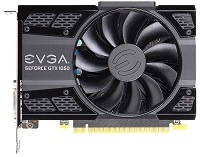

General info
The main nomenclature characteristics of video cards NVIDIA GeForce GTX 1050 Ti and NVIDIA GeForce 9800 GTX+. Pay attention to the position in the performance rating to choose the best one.
Technical specs
Choose the best graphics card between NVIDIA GeForce GTX 1050 Ti and NVIDIA GeForce 9800 GTX+ based on manufacturing process, power consumption, and base frequency and overclocking potential of the GPU.
Compatibility, dimensions and requirements
Additional technical information, does not greatly affect the performance rating when comparing the NVIDIA GeForce GTX 1050 Ti and NVIDIA GeForce 9800 GTX+.
Memory
Graphics card memory is used to store calculations. Modern software and 3D games require more and faster memory. The higher these parameters, the more productive the chip. The difference in these characteristics NVIDIA GeForce GTX 1050 Ti and NVIDIA GeForce 9800 GTX+ can be seen in this section.
Video outputs and ports
The difference between the interfaces and ports of video cards NVIDIA GeForce GTX 1050 Ti and NVIDIA GeForce 9800 GTX+, the size and number of monitors.
Technologies
The difference between NVIDIA GeForce GTX 1050 Ti and NVIDIA GeForce 9800 GTX+ is the additional functionality.
API support
The difference in supported APIs is NVIDIA GeForce GTX 1050 Ti and NVIDIA GeForce 9800 GTX+. Hardware support (API) is not considered in synthetic benchmarks and performance tests.
Gaming performance
Select form the list the required name to identify gaming performance for NVIDIA GeForce GTX 1050 Ti and NVIDIA GeForce 9800 GTX+ graphics cards. The result shows how fast the game will run and whether it can be run on this computer. The different monitor resolutions – from low to 4K – are used for testing. Find out is the NVIDIA GeForce GTX 1050 Ti or NVIDIA GeForce 9800 GTX+ good for gaming.
|
low
1280x720 |
med.
1920x1080 |
high
1920x1080 |
ultra
1920x1080 |
QHD
2560x1440 |
4K
3840x2160 |
||
| Horizon Zero Dawn (2020) | NVIDIA GeForce GTX 1050 Ti | ||||||
| NVIDIA GeForce 9800 GTX+ | |||||||
| Death Stranding (2020) | NVIDIA GeForce GTX 1050 Ti | ||||||
| NVIDIA GeForce 9800 GTX+ | |||||||
| F1 2020 (2020) | NVIDIA GeForce GTX 1050 Ti | 44.7 | 32.3 | 17.6 | |||
| NVIDIA GeForce 9800 GTX+ | |||||||
| Gears Tactics (2020) | NVIDIA GeForce GTX 1050 Ti | 200 | 71.7 | 44.3 | 32.6 | 20.6 | |
| NVIDIA GeForce 9800 GTX+ | |||||||
| Doom Eternal (2020) | NVIDIA GeForce GTX 1050 Ti | 101 | 62.9 | 55.5 | 52.9 | 39.3 | |
| NVIDIA GeForce 9800 GTX+ | |||||||
| Legend | |
| 5 | Stutter – Insufficient data. Similar graphics cards stutter, the game is likely to show a low frame rate. There will be some lags. |
| May Stutter – Insufficient data. Similar graphics cards stutter, the game is likely to show a low frame rate. There will be some lags. | |
| 30 | Fluent – According to the results of benchmarks the game should run at 25 frames per second (fps) |
| 40 | Fluent – According to the results of benchmarks the game should run at 35 frames per second (fps) |
| 60 | Fluent – According to the results of benchmarks the game should run at 58 frames per second (fps) |
| May Run Fluently – Insufficient data. Similar graphics cards show a smooth frame rate, comfortable for the game. | |
| ? | Uncertain – Graphics cards testing has shown that a slower card can provide a high and stable frame rate for the same operation. |
| Uncertain – The work of the video card in the game is still being studied. Interpolation among analogs is not possible. | |
| The value depicts the average frame rate. Hovering over the value, you can get individual results. | |
Advantages of NVIDIA GeForce GTX 1050 Ti
26.2% faster in synthetic tests
More pipelines (768 vs 128)
Finer manufacturing process technology (16 nm vs 55 nm)
Less power consumption (75 Watt vs 141 Watt)
More memory bandwidth (112 GB/s vs 70.4 GB/s)
G-SYNC support
VR Ready
Multi Monitor
Advantages of NVIDIA GeForce 9800 GTX+
Cheaper ($91 (0.4x MSRP) vs $350 (2.5x MSRP))
More maximum RAM amount (512 MB vs 4 GB)
So, NVIDIA GeForce GTX 1050 Ti or NVIDIA GeForce 9800 GTX+?
Judging by the results of synthetic and gaming tests, we recommend NVIDIA GeForce GTX 1050 Ti .

















